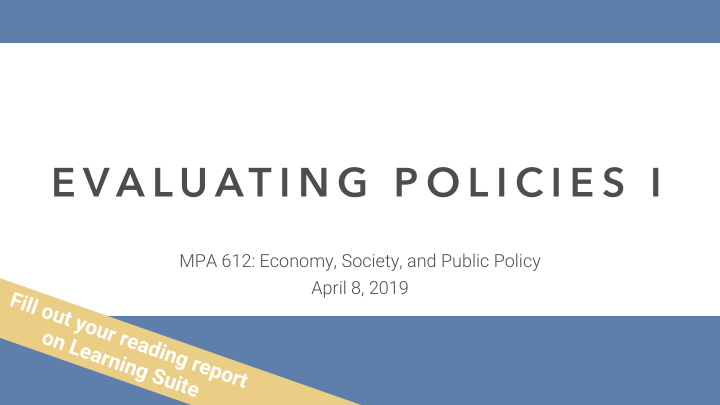



E V A L U AT I N G P O L I C I E S I MPA 612: Economy, Society, and Public Policy April 8, 2019 Fill out your reading report on Learning Suite
P L A N F O R T O D A Y What is CBA? Nine simple steps of CBA CBA example
W H AT I S C B A ?
My way is to divide half a sheet of paper by a line into two columns; writing over the one Pro and over the other Con.… When I have thus got them altogether in one view, I endeavor to estimate their respective weights; and where I find two, one on each side, that seem equal, I strike them both out.… [T]hus proceeding, I find where the balance lies; and if after a day or two of further consideration… , I come to a determination accordingly. Benjamin Franklin
At its core, CBA is just Franklin’s pro/con list, but for society Easy logic Net social benefit = benefits − costs
C B A I N G O V E R N M E N T 1936: Army Corps of Engineers 1950s–70s: Experimentation 1981: Reagan’s EO 12291 and RIA 1994: Clinton’s EO 12866
T Y P E S O F C B A ex ante in medias res ex post
W H O U S E S C B A ? Executive agencies Legislators Courts Cities and states Nonprofits and foundations Aid agencies
CBA is deceptively hard and complicated and expensive in real life
… There are benefits, of course, which may be countable, but which Have a tendency to fall into the pockets of the rich. While the costs are apt to fall upon the shoulders of the poor. So cost-benefit analysis is nearly always sure. To justify the building of a solid concrete fact, While the Ecologic Truth is left behind in the Abstract. Kenneth E. Boulding, “A Ballad of Ecolocial Awareness” (1973)
N I N E S I M P L E S T E P S O F C B A lolz
1. Specify the set of alternative projects List all the possible alternatives Keep status quo if still viable Asphalt or concrete 4 different routes 2, 3, 4, or 6 lanes No tolls, low tolls, high tolls Elk tunnels? Begin construction now or later
2. Decide whose benefits and costs count Standing Just citizens of city/state/country? Just people currently alive?
3. Identify impacts and measure them Impacts = inputs and outputs Think of every possible thing involved
You live in a city that currently does not require bicycle riders to wear helmets. You like riding your bicycle without a helmet. From your perspective and society’s perspective, what are the major costs and benefits of a proposed city ordinance that would require all riders to wear helmets? How might you measure these?
4. Predict the impacts quantitatively over the life of the project Make predictions for each of the impacts from step 3 Figure out number of vehicle trips on new highway + old roads Extrapolate and estimate driving costs saved, accidents avoided, lives saved, etc.
5. Monetize all impacts Put everything in the same scale: $$$ Market prices Shadow prices
Statistical life ≠ individual life What did Colbert claim? What was wrong? Value of a statistical life How much people are willing to pay for a reduction in the probability of death, extrapolated to 100% Like a demand curve for injury and death
Contingent evaluation Ask people what they’d be willing to pay to lower their risk of death Surveys, focus groups, guesses
Revealed preferences Look at what people pay in real life Low risk jobs pay less than high risk jobs, so higher wage = WTP for reduction in risk
Contingent evaluation vs. revealed preferences We tend to trust people’s own revealed safety vs. money preferences But, it’s tricky
$40,000 Annual income $30,000 $20,000 $10,000 0.05% 0.10% 0.15% 0.20% 0.25% Annual job − related fatality risk
Coefficient × 100,000 × average hours worked per year 0.0395 × 100,000 × (42.57 × 52) = $8.74 million potential work experience + potential work experience squared + years of education + indicator variables for male, married, Black, Native American, Asian, Hispanic ethnicity, doctorate or professional degree earned, paid hourly rate, full-time employment, union or employee association membership, government employment, six metropolitan and Off because of rounding nonmetropolitan areas, eight regional areas, nine largely blue-collar occupations, and professional occupational group Others, like NHTSA
VSL = $50,000
<latexit sha1_base64="Wm/TWDbS8gT9D0z1nUw1knJet4=">ACAnicbVDLSsNAFL2pr1pfUXe6GSxCRSiJCOpCKArisoJ9QBvLZDph04ezEyEgJu/BU3LlTc+hXu/BsnbRZaPXDhcM693HuPG3EmlWV9GYW5+YXFpeJyaWV1bX3D3NxqyjAWhDZIyEPRdrGknAW0oZjitB0Jin2X05Y7usz81j0VkoXBrRpH1PHxIGAeI1hpqWfu1JvoHU9gUly1UyTio0OkTi4U2mpZ5atqjUB+kvsnJQhR71nfnb7IYl9GijCsZQd24qUk2ChGOE0LXVjSNMRnhAO5oG2KfSY/pGhfK3khUJXoNBE/TmRYF/Kse/qTh+roZz1MvE/rxMr79RJWBDFigZkusiLOVIhygJBfSYoUXysCSaC6VsRGWKdh9KxZSHYsy/JY2j6lnVvjku1y7yNIqwC3tQARtOoAbXUIcGEHiAJ3iBV+PReDbejPdpa8HIZ7bhF4yPbwRflWU=</latexit> <latexit sha1_base64="Wm/TWDbS8gT9D0z1nUw1knJet4=">ACAnicbVDLSsNAFL2pr1pfUXe6GSxCRSiJCOpCKArisoJ9QBvLZDph04ezEyEgJu/BU3LlTc+hXu/BsnbRZaPXDhcM693HuPG3EmlWV9GYW5+YXFpeJyaWV1bX3D3NxqyjAWhDZIyEPRdrGknAW0oZjitB0Jin2X05Y7usz81j0VkoXBrRpH1PHxIGAeI1hpqWfu1JvoHU9gUly1UyTio0OkTi4U2mpZ5atqjUB+kvsnJQhR71nfnb7IYl9GijCsZQd24qUk2ChGOE0LXVjSNMRnhAO5oG2KfSY/pGhfK3khUJXoNBE/TmRYF/Kse/qTh+roZz1MvE/rxMr79RJWBDFigZkusiLOVIhygJBfSYoUXysCSaC6VsRGWKdh9KxZSHYsy/JY2j6lnVvjku1y7yNIqwC3tQARtOoAbXUIcGEHiAJ3iBV+PReDbejPdpa8HIZ7bhF4yPbwRflWU=</latexit> <latexit sha1_base64="Wm/TWDbS8gT9D0z1nUw1knJet4=">ACAnicbVDLSsNAFL2pr1pfUXe6GSxCRSiJCOpCKArisoJ9QBvLZDph04ezEyEgJu/BU3LlTc+hXu/BsnbRZaPXDhcM693HuPG3EmlWV9GYW5+YXFpeJyaWV1bX3D3NxqyjAWhDZIyEPRdrGknAW0oZjitB0Jin2X05Y7usz81j0VkoXBrRpH1PHxIGAeI1hpqWfu1JvoHU9gUly1UyTio0OkTi4U2mpZ5atqjUB+kvsnJQhR71nfnb7IYl9GijCsZQd24qUk2ChGOE0LXVjSNMRnhAO5oG2KfSY/pGhfK3khUJXoNBE/TmRYF/Kse/qTh+roZz1MvE/rxMr79RJWBDFigZkusiLOVIhygJBfSYoUXysCSaC6VsRGWKdh9KxZSHYsy/JY2j6lnVvjku1y7yNIqwC3tQARtOoAbXUIcGEHiAJ3iBV+PReDbejPdpa8HIZ7bhF4yPbwRflWU=</latexit> <latexit sha1_base64="Wm/TWDbS8gT9D0z1nUw1knJet4=">ACAnicbVDLSsNAFL2pr1pfUXe6GSxCRSiJCOpCKArisoJ9QBvLZDph04ezEyEgJu/BU3LlTc+hXu/BsnbRZaPXDhcM693HuPG3EmlWV9GYW5+YXFpeJyaWV1bX3D3NxqyjAWhDZIyEPRdrGknAW0oZjitB0Jin2X05Y7usz81j0VkoXBrRpH1PHxIGAeI1hpqWfu1JvoHU9gUly1UyTio0OkTi4U2mpZ5atqjUB+kvsnJQhR71nfnb7IYl9GijCsZQd24qUk2ChGOE0LXVjSNMRnhAO5oG2KfSY/pGhfK3khUJXoNBE/TmRYF/Kse/qTh+roZz1MvE/rxMr79RJWBDFigZkusiLOVIhygJBfSYoUXysCSaC6VsRGWKdh9KxZSHYsy/JY2j6lnVvjku1y7yNIqwC3tQARtOoAbXUIcGEHiAJ3iBV+PReDbejPdpa8HIZ7bhF4yPbwRflWU=</latexit> 6. Discount benefits and costs to obtain present values Present value = value of an amount that occurs in the future FV PV = (1 + r ) t
Why discount? Costs of public projects are front loaded Benefits occur over a long period of time How do we know if the benefits over time are worth the initial costs?
Discount rates Opportunity costs Time value of money OMB Circular A-94 Appendix C 1%, 3%, 7%, then sensitivity analysis World Bank uses 10%
Recommend
More recommend